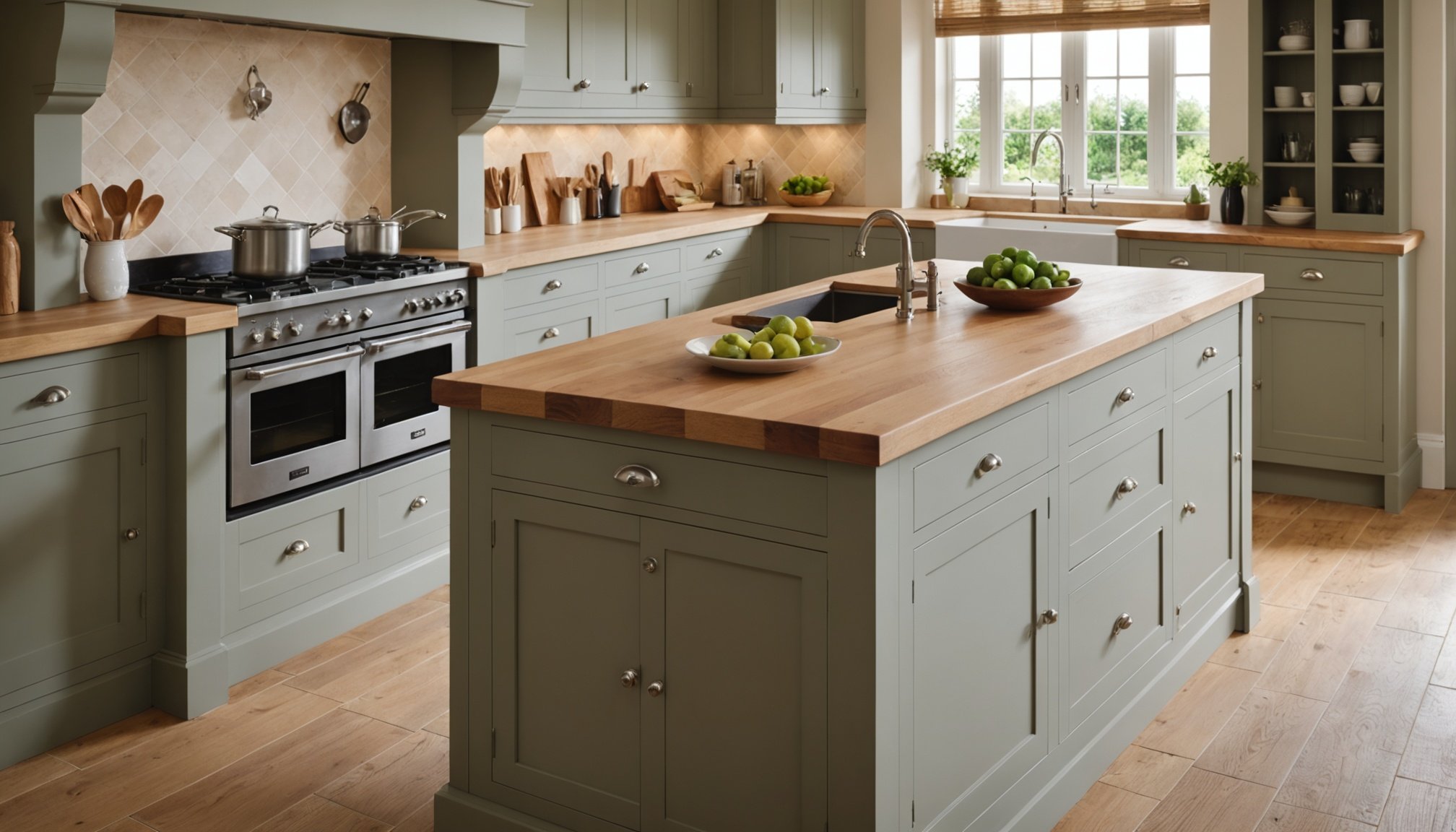Understanding Oak Worktops
Oak worktops are renowned for their durability and elegance, making them a popular choice in UK kitchens. The unique characteristics of oak wood enhance its appeal. Oak is a hardwood, recognised for its strength and resilience, which is why it’s a preferred material for worktops. This robustness ensures that oak worktops withstand heavy use and resist dents and scratches, maintaining their aesthetic appeal over time.
A standout benefit of oak worktops is their natural beauty. The warm, rich grain patterns and honey-toned hues add a touch of sophistication to any kitchen. These features allow oak worktops to complement both traditional and modern kitchen designs seamlessly. Moreover, oak’s versatility means it can be stained or treated to match various interior themes, enhancing its adaptability.
Have you seen this : Ultimate guide to installing an exceptional kitchen ventilation system for your uk home
In addition to aesthetics, oak worktops are environmentally friendly. Oak trees can be sustainably sourced, aligning with eco-conscious home choices. The natural oils in oak provide an inherent resistance to bacteria and moisture, serving practical purposes in busy kitchens. These qualities not only assure cleanliness but also extend the lifespan of the worktops, making oak a wise investment.
Essential Care Tips for Oak Worktops
Caring for oak worktops requires a strategic maintenance plan to ensure their longevity and beauty. Daily cleaning routines are essential for preserving the natural elegance of oak surfaces. To maintain optimal condition, use a soft cloth with mild soap and water, followed by drying with a clean towel. This method prevents water spots and ensures your worktop remains free of grime.
Also to discover : Quick recipes and flavors: fast meals for every palate
Implementing best practices for preventing wear and tear is crucial. Using coasters under hot or damp items can protect the finish from heat damage and moisture. Additionally, placing cutting boards under knives or heavy kitchen tools will minimise scratches, preserving the smooth texture. Adopting these simple habits significantly contributes to the oak’s long-term durability.
Avoiding harmful cleaning agents is paramount in your maintenance strategy. Harsh chemicals or abrasive materials can erode the finish, leading to damage. Opt for gentle, natural products instead. By doing so, you ensure the oak retains its sheen and resilience over time. Ultimately, conscientious care tips and cleaning techniques uphold the value and aesthetic of your oak worktops, ensuring they remain a timeless asset within any kitchen setting.
Deep Cleaning Procedures
When it comes to deep cleaning, selecting the right cleaning products is crucial. To effectively remove tough stains, opt for products that cater specifically to the material and type of stain. Commonly recommended products include enzyme cleaners for organic debris and oxidising agents for lifting tough stains.
Tackling Tough Stains
For optimal results, a step-by-step approach is essential. First, identify the stain’s origin. Understanding whether it’s oil, wine, or ink will guide your product choice. Begin by gently blotting the stain with a clean cloth to remove excess residue. Avoid rubbing, as this can push the stain deeper into the fabric. Apply your chosen cleaning product according to the manufacturer’s instructions, ensuring complete coverage of the stain. Allow it to sit for the recommended time before rinsing or blotting away with warm water.
Frequency of Deep Cleaning
Regular maintenance is key. For most surfaces like carpets or upholstery, a deep cleaning every 3 to 6 months is advisable. However, high-traffic areas might require more frequent attention. Ensuring regular deep cleaning not only extends the life of your furnishings but also contributes to a healthier home environment. By integrating these deep cleaning practices into your routine, you’ll maintain immaculate surfaces year-round.
Oiling and Finishing Oak Worktops
Oiling oak worktops is crucial for maintaining their beauty and durability. Choosing suitable oils is the first step. Danish oil, tung oil, and linseed oil are the most preferred options, each offering unique benefits. Danish oil provides a rich tone and dries quickly, making it ideal for busy kitchens. Tung oil, known for its water resistance, is excellent for worktops exposed to moisture. Linseed oil, a traditional choice, imbues a warm finish but may require more frequent applications.
Proper Oiling Technique
To properly oil your worktop, start by cleaning the surface to remove any debris. Apply the oil with a soft cloth in the direction of the grain, ensuring a thin and even coat. Allow it to penetrate the wood for up to 15 minutes before wiping away the excess to prevent a sticky residue. After the initial application, repeat the process two to three times, waiting 12 hours between coats for the best results.
Signs Your Worktop Needs Re-Oiling
Recognising when your worktop requires re-oiling is essential. If water no longer beads on the surface or the finish appears dull, it’s time for reapplication. Regular re-oiling enhances the protective coating, preserving the worktop’s condition and aesthetics.
Repairing Scratches and Damage
Repairing scratches and controlling damage on oak worktops is essential to maintaining their aesthetic appeal and longevity. Common types of damage, such as minor scratches and dents, can arise from everyday use but can usually be addressed using simple restoration techniques. With some DIY repair methods, minor scratches can be effectively minimized.
For minor blemishes, you can lightly sand the affected area using fine-grit sandpaper, ensuring the surface remains even. After sanding, apply a wood stain or oil that matches the oak’s natural color to restore its appearance. These minor repairs can often be done with tools and materials found at home, making them a cost-effective solution for many homeowners.
However, there are instances when the damage exceeds minor scratches and requires a professional touch. Deep gouges, extensive water damage, or structural issues could necessitate a professional’s expertise. A professional craftsman can provide the necessary skills and equipment to restore the worktop to its original condition, ensuring the repair is invisible and long-lasting.
By understanding when to undertake DIY repairs and when to seek professional help, oak worktop owners can ensure their surfaces remain beautiful and functional for years. Making informed decisions about damage control will preserve the worktop’s integrity and value.
Preventing Damage to Oak Worktops
Protecting oak worktops involves key damage prevention strategies and adopting smart kitchen habits. Start by safeguarding against heat and moisture, both common culprits in oak surface vulnerabilities. Place heat-resistant pads or trivets under hot pans and dishes to prevent warping or discolouration. Additionally, wipe up spills immediately and maintain a dry surface whenever possible, as prolonged exposure to moisture can lead to swelling and cracking.
Kitchen habits also play a vital role in preserving your oak worktop. For instance, use a cutting board to avoid knife marks and scratches. This simple habit preserves the surface’s integrity and natural beauty. Moreover, refrain from dragging heavy kitchen appliances across the surface to prevent gouges and dents.
Finally, consider the positioning of furniture and appliances. Position items to allow sufficient airflow around your worktop to minimise moisture build-up from inadequate ventilation. Placing worktops away from direct heat sources, like ovens or heaters, further restricts unnecessary temperature fluctuations.
By adopting these protective measures and practices, you can maintain the elegance and functionality of your oak worktops for years to come. Mindful habits and thoughtful furniture arrangements can significantly extend the life and beauty of this timeless kitchen element.
Products to Use for Oak Worktop Maintenance
Maintaining your oak worktop is crucial for both aesthetics and longevity. Ensuring regular maintenance can keep your worktop looking pristine. Key to this is selecting the right maintenance products. A variety of recommended items can cater to your specific needs, with numerous oil options that provide distinct benefits.
Commercially Available Oils and Cleaners:
The market offers an extensive range of oils and cleaners. These products are specifically formulated to penetrate deeply into the wood, ensuring moisture resistance and a satin finish. On the shelves, you’ll find various oil options like linseed or tung oil, each offering distinct advantages depending on your preferences.
Advantages of Natural vs. Synthetic Products:
Natural oils, such as Danish and mineral oil, are popular for their non-toxic properties and rich finishes, enhancing the wood’s natural grain. Conversely, synthetic products may offer better protective durability and are often UV-resistant, making them ideal for busy kitchens or sunlit spaces.
User-Recommended Brands and Their Features:
Many users endorse brands that balance quick drying times and lasting protection. Popular brands incorporate both natural and synthetic options, ensuring everyone finds the perfect fit for their oak worktops. Always consider the specific characteristics of each brand’s formulation to meet your requirements.
Frequently Asked Questions
Below are some of the common concerns and queries regarding oak worktop maintenance, tailored for both first-time owners and seasoned users alike.
Addressing Myths About Oak Worktop Care
A widespread myth is that oak worktops require excessive care. Truthfully, regular maintenance is straightforward. Routine cleaning with a damp cloth and mild detergent suffices for everyday care. Additionally, using food-safe oils for annual treatment keeps your worktop in excellent condition.
Clarifying Product Usage and Maintenance Frequency
Do oak worktops need special products for cleaning? Not necessarily. Simply avoid harsh chemicals, which can damage the finish and grain of the oak. For maintaining the natural beauty of your worktop, oiling every six to twelve months is recommended. This practice ensures the wood remains hydrated, enhancing its longevity and resistance to stains.
Tips for First-Time Oak Worktop Owners
- Avoid placing hot pots directly on the surface; use trivets instead.
- Clean spills promptly to prevent water damage.
- Implement a chopping board to maintain the surface quality.
These straightforward practices, combined with routine maintenance, will keep your oak worktop in pristine condition, allowing it to serve as a beautiful and functional element in your kitchen.










